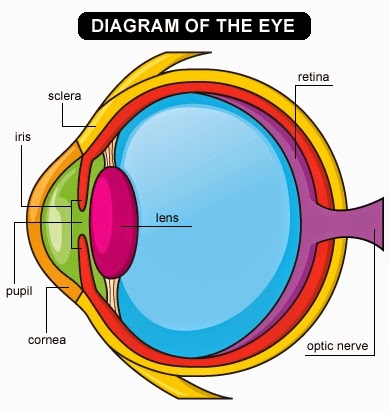Q❓&→ A❕ About your eyes
Q: Why some people need glasses and others don't❓
A: Because everybody's eyes are a little different -
Not just the color, but the way they work and how well they see❕ Sometimes all the parts of the eye don't work together the way they should. However, eyeglasses or contact lenses can help see more clearly.
A: The eyeball includes the cornea; clear tissue that helps the eye focus, the iris; the colored part,
the pupil; the black circle in the center of the iris which is really an opening in the iris that lets light enter the eye, the lens; which also helps the eye focus,
and the retina; at the very back of the eye.
A: Nearsightedness and farsightedness are common refractive problems. It's easy to get the two confused:
The shape and size of a person's eyeballs usually cause refractive problems.
Another refractive problem is called astigmatism. This means that the cornea is an uneven shape, and it bends the light in different directions. This can distort what a person sees and make things look blurry. Glasses or contact lenses correct vision because they allow the eye to focus light in the right spot on the retina - the spot that produces the clearest image.
We have a variety of lenses for all types of eyes including nearsighted, farsighted and astigmatism.
A: Because everybody's eyes are a little different -
Not just the color, but the way they work and how well they see❕ Sometimes all the parts of the eye don't work together the way they should. However, eyeglasses or contact lenses can help see more clearly.
Q: How does the human eye work❓ ⊙ܫ⊙
A: The eyeball includes the cornea; clear tissue that helps the eye focus, the iris; the colored part,
the pupil; the black circle in the center of the iris which is really an opening in the iris that lets light enter the eye, the lens; which also helps the eye focus,
and the retina; at the very back of the eye.
When all of these parts of the eyes are working properly, there will not be a vision problem. You can see because your eyes capture an image like a camera and send that image to your brain, where it can be interpreted. Your eyes need to bend light rays so the image can be focused sharply on your retina. The better your retina records the image, the more likely that your brain will interpret the image, and the more likely you will see the image clearly❕
Refracting is a big word that means bending light rays. If a person has a vision problem, it's often a refractive problem. So, to correct refractive problems, eyeglasses or contact lenses are needed in order to bend the light rays in a way that lets you see more clearly.
Q: Nearsighted and Farsighted — Which Is Which❓
A: Nearsightedness and farsightedness are common refractive problems. It's easy to get the two confused:
- Nearsighted (a.k.a myopia) means someone can see stuff that's near; like a book, but has trouble seeing stuff that's far away❕
- Farsighted (a.k.a hyperopia) means someone may be able to see stuff that's far away clearly, but has more trouble seeing up close like reading the print in a book❕
The shape and size of a person's eyeballs usually cause refractive problems.
Another refractive problem is called astigmatism. This means that the cornea is an uneven shape, and it bends the light in different directions. This can distort what a person sees and make things look blurry. Glasses or contact lenses correct vision because they allow the eye to focus light in the right spot on the retina - the spot that produces the clearest image.
Remember, the target is right in the center of the
RETINA❕
We have a variety of lenses for all types of eyes including nearsighted, farsighted and astigmatism.
Come & Visit www.e-circlelens.com




Comments
Post a Comment